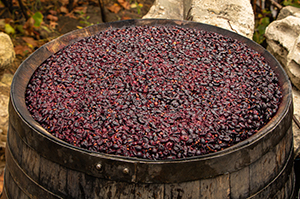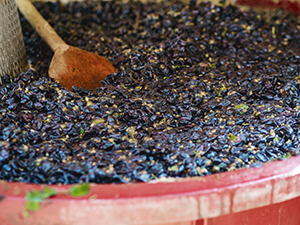Extended Maceration: A Deep Dive into the Art of Longer Skin Exposure
Posted by Matteo Lahm on 7th Apr 2025
If you are making wine from fresh grapes or kits that come with skins, you might have the common concern that most winemakers have about too much exposure to the skins and seeds. You fear your wine becoming too tannic and might even press the wine before fermentation is even completed just to be safe. However, what if you didn’t have to worry about that? Furthermore, what if there is a long history of techniques for long-term skin exposure that could do wonders for your wine? Welcome to the world of extended maceration!
The origins of extended maceration are as old as the hills and as fascinating as the wine it helps create. Extended maceration is a technique that has been used since the days of the ancient Romans. It's like the secret sauce of winemaking, especially beneficial for robust grape varieties like Cabernet Sauvignon, Petite Sirah, Syrah, and Nebbiolo. These grapes, with their thick skins and high tannin content, are the perfect candidates for this process.
So, how is it done? Well, it's all about letting the grape skins hang out in the juice for an extended period after fermentation. This isn't a quick meet-and-greet, but a long, leisurely get-together, sometimes lasting up to four weeks or more. The goal? To extract as much color, flavor, and tannin as possible.

Sounds great right? Well, it can be, but you need to understand the process and be aware of some techniques if you are to try it with your wine. To begin, monitor fermentation and when your must reaches an SG of about 1.010, it is producing much less carbon dioxide. Punch down your must cap one last time and close your fermenter. If you plan to use this process, it is best to work with a fermenter you can close. Standard fermenters with snap lids and an airlock port work perfectly as do variable steel tanks.
If you don’t have either, you can also wrap the top of your fermenter with shrink wrap. There will be enough space for gas to escape and since CO2 is heavier than O2, that bed of gas will protect your wine. Keep in mind that the last increments of fermentation are slow so your wine will continue processing the last tiny increments of sugar for weeks after your hydrometer can no longer read the changes.
But, like any good thing, there's a catch. Extended maceration isn't without its risks. The longer the skins are in contact with the juice, the higher the chance of microbial spoilage. It's like inviting a bunch of rowdy guests to a party - if you don't keep an eye on them, things can get out of hand pretty quickly. One way to help prevent this from happening is to only employ this process with big-bodied wines with higher acidity and alcohol levels. A 14% Cabernet Sauvignon with a 3.4 pH is a ripe candidate for this process. Higher ABV and acidity will help protect from spoilage. Therefore, this process is not recommended for light-medium bodied lower ABV wines. This is not only because of spoilage either. Lighter wines cannot support the tannins.
Speaking of the devil, let's talk about the tannins. These are the compounds that give wine its structure and longevity. Extended maceration can significantly alter the tannin profile of your wine, making it more complex and layered. But remember, it's a delicate balancing act. Too little time on the skins, and your wine may lack depth. Too much time, and you risk over-extraction, leading to a wine that's as harsh as a critic's review. So how should you proceed?
The simplest and most straightforward technique is to leave your wine on the skins for an extra week. That extra time will give you a more complex tannin profile and produce a wine that has a lot more nuance and is capable of longer-term aging.
If you want to try extending it longer, you will have to do some extra work, but the results might be worth it. Many winemakers will get the wine off the seeds and remove the destroyed macerated skins only leaving the skins that are still whole. Seed and stem tannins are smaller and more bitter so removing them is essential to longer-term extended maceration. Skin tannins mostly contribute to mouthfeel and provide additional structure.
An easy approach for the home winemaker would be to remove the skins from the must cap at the top. Then drain the wine off the seeds, press the remaining skins and discard them. Do your best to not put the seeds at the bottom in your wine press. After two weeks of alcohol exposure, they are more fragile and when they break, let the bitterness flow. This may lower your yield a bit, but it is a necessary loss/gain scenario.

Transfer your wine back into the fermenter, put the good skins back and leave as little headspace as possible. Make sure your skins are soaked before you close your fermenter. If you cannot get close to the top, you could add your own CO2 using cartridges. This will give you the tannins you want and get rid of the ones you don’t.
Now that you understand how to proceed, let’s talk about tannin chains and how extended maceration affects them. Tannins are naturally occurring compounds in grape skins, seeds, and stems. They're what give wine its structure and mouthfeel. During extended maceration, these tannins have more time to interact with the juice, leading to the formation of longer tannin chains.
Now, why does this matter? Well, longer tannin chains are generally perceived as being smoother and less astringent than shorter ones. They give the wine a velvety, rounded mouthfeel that's often described as 'silky' or 'plush'. So, by extending the maceration period, winemakers can manipulate the tannin structure of the wine, making it more complex and enjoyable to drink.
If you opt for a shorter extended maceration period, say one week, you'll likely end up with a wine that has a brighter fruit profile and softer tannins. It's like a quick dip in the pool - refreshing and invigorating, but not too intense.
On the other hand, if you let the skins hang out with the juice for a month or more, you're going to see a significant shift in the wine's profile. The fruit flavors may become more concentrated and the tannins more pronounced. It's like a long soak in a hot tub - deep, intense, and utterly relaxing. Of course, if you go this route, you will need to age your wine longer. Tannins form chains when wine ages and when the chains get longer, the compounds are large enough not to enter those little crevices in your tongue that register bitterness. If you have the patience and self-control to wait, hats off to you because the rewards will be splendid, but this is not an endeavor of instant gratification.
But what if you're one of those adventurous winemakers who likes to push the envelope? What if you leave the skins in contact with the juice for several months? Well, you're entering uncharted territory here. The tannin structure of your wine could become incredibly complex, with a multitude of layers and nuances. The fruit flavors might evolve into darker, more brooding notes. It's like a journey into the heart of the wine, a journey that can yield some truly remarkable results.
But remember, with great power comes great responsibility. Extended maceration is a powerful tool, but it needs to be used wisely. Too much of a good thing can tip the balance and result in a wine that's overly tannic or lacking in freshness. So, tread carefully, fellow winemakers, and let your palate be your guide.
In conclusion, extended maceration is like the spice in your winemaking recipe. Used wisely, it can enhance the flavor, color, and complexity of your wine. But like any spice, it should be used judiciously. After all, we're making wine here, not hot sauce! So, go ahead, experiment with extended maceration, and let your wines tell their own unique stories. Just remember to keep things in check, because as we all know, in winemaking, as in life, balance is key. Good luck!

